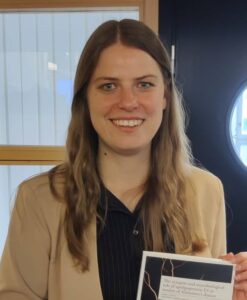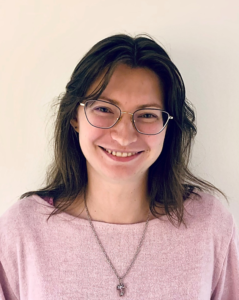Oxana Klementieva, PhD, Docent, Associate Professor (Senior Lecturer)

Bodil Israelsson
Valeriia Skoryk, PhD, MD, Researcher
I’m MD in pathology and find that clinical practice is only possible with the support of research and vice versa. Therefore, in my research group’s analysis of the incurable neurodegenerative pathology of Alzheimer’s disease.
I’ve focused primarily on building a multimodal approach that incorporates a variety of non-invasive techniques whose data are confirmed by invasive counterparts. This approach allows us to obtain information on many pathobiological aspects of the disease that brings us very close to the actual situation in the human brain, and the results of the non-invasive technique can be more easily applied to a patient case. So, my goal is to develop clinical and morphological perspectives to transfer and confirm the results of the animal models to human tissues.
Sabine Konings, Postdoctoral researcher

I am investigating whether ApoE isoforms (particularly ApoE4) differently affect intraneuronal Aβ aggregations at synaptic terminals in cultured AD neurons using high-resolution techniques (infrared microscopy, fluorescence microscopy).
ApoE4 is the major genetic risk factor for AD and our project will contribute to a better understanding of ApoE4 in Aβ aggregation in early AD stages.
Agnes Paulus, Postdoctoral researcher

In my research, I study changes occurring during protein misfolding with a method called Fourier-transformation infrared (FTIR) spectroscopy. FTIR is a classical non-destructive spectroscopic method used to analyze the secondary structure of proteins and lipids.
Using FTIR spectroscopy, I study lipids and protein misfolding occurring in neurodegenerative proteinopathies, postmortem delay, various brain tissue processing as possible factors affecting the structure of proteins and lipids, and finally changes in brain tissue after focal cerebral ischemia in an animal model of experimental stroke. I investigate brain tissue using different FTIR approaches, infrared FPA Imaging systems, synchrotron-based infrared microspectroscopy, and O-PTIR which is a super-resolution imaging approach. The various infrared approaches provide multiscale capabilities results with resolution from micro- to nano-scale. I have in prospect to find valuable information about changes occurring in the brain tissue, as well as insight into the molecular mechanisms of protein and lipid reactions leading to structural changes in proteinopathies, ischemic stroke, and postmortem delay.
Radhika Thakore, PhD candidate

Fifty percent of the Alzheimer’s disease patients exhibit co-pathology with α-synuclein (α-syn) and these patients have an aggressive disease course. My research interest is studying the protein interaction of amyloid-β (Aβ) and α-synuclein (α-syn) responsible in Alzheimer’s disease, using a newly developed mice model harbouring both human Aβ and α-syn. Studying the protein interaction of human Aβ and α-syn will be helpful to understand the crosstalk of amyloid proteins relevant to AD pathogenesis.
Markus Aldén, MSc student

Pablo De-Castro, BSc student

Spatial profiling of amyloid structures plays a crucial role in investigating the molecular mechanisms underlying neurodegenerative amyloidoses, including Alzheimer’s disease. However, current methods for molecular analysis of large biological specimens imaged in three dimensions are limited.
My research project focuses on validating the utilization of nanotomography as a label-free approach for detecting amyloid beta plaques in the brain and spinal cord. Subsequently, I use downstream immunohistochemistry to further characterize these amyloid plaques detected by by tomography.
Previous members


Project: Sex differences in Alzheimer’s disease remain poorly understood, despite evidence that women are disproportionately affected in both prevalence and severity.
My research project focuses on understanding how amyloid-β (Aβ) pathology develops in different stages of Alzheimer’s disease (AD), with particular attention to differences between brain regions and between sexes. By studying a knock-in mouse model, I aim to uncover biological factors that may contribute to the heightened vulnerability observed in females, ultimately informing efforts toward earlier diagnosis and more targeted interventions.

